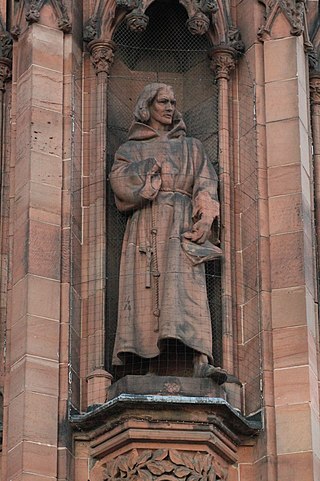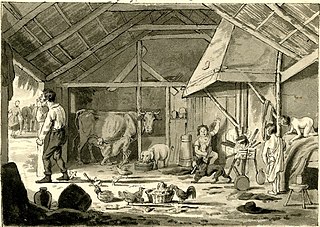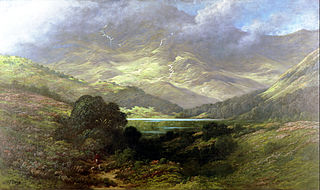
The Tua Mariit Wemen and the Wedo or The Tretis Of The Twa Mariit Wemen and the Wedo ('The conversation of the two married women and the widow') is a narrative poem in Scots by the makar William Dunbar.

The Tua Mariit Wemen and the Wedo or The Tretis Of The Twa Mariit Wemen and the Wedo ('The conversation of the two married women and the widow') is a narrative poem in Scots by the makar William Dunbar.
The poem dates to the late fifteenth or early sixteenth centuries and is written in the archaic form of alliterative verse rather than the rhyming verse more typical of Scots poetry of the time.
It survives in The Chepman and Myllar Prints of 1508, held in the National Library of Scotland and, as a fragment, in the Maitland Manuscripts, held in the Pepys Library. [1] It is also now available online archive of medieval texts in an annotated version (see External Links below).
The poem describes an unnamed narrator's overhearing of a discussion between three women in a garden. The women speak frankly and at length of marriage and their experiences with their husbands. The discussion of sexuality is often in language which is earthy and uninhibited. [2] The work ends with the narrator asking the reader,
or, in English,
This page is a candidate for copying over to Wikisource. |
The narrator is walking alone in the country on a Midsummer night admiring the beauty of nature,
In a hedged garden he notices three women,
He eavesdrops on their conversation, hoping for amusement. One of the women, a widow, asks her two younger, married companions about their opinion of marriage,
The first wife responds by telling the others about her unhappy marriage to an older, unattractive man.
She adds that while he is a poor lover, he is also wealthy and generous.
The second wife speaks next and tells the others that her husband is young but also lacking as a lover due to a lecherous past.
He is vain and boasting.
She adds that she would like a new lover,
The widow speaks next. She begins by advising her friends to emulate her behaviour of adopting a gentle persona while remaining secretly ruthless.
She summarises this approach as,
She reveals that she has been married twice. Her first husband, like that of the first wife, was an older man.
She meanwhile had a younger lover,
She gave birth to a son, but confides that her husband was impotent by the time of his conception. She persuaded him to bequeath his property to the boy.
Her second marriage was to a wealthy merchant, whom she considered to be socially inferior.
She intimidated the man with constant reminders of his supposedly low birth.
He is persuaded by her intimidation to will his property to her son.
She continued to dominate her husband, whom she refers to as 'wife',
She obtained valuable possessions from him,
She then promoted her own children while denigrating her husband's children.
She didn't mourn his death.
Once widowed, she adopted traditional mourning customs, insincerely.
She took a secret lover.
She receives suitors, but does not take them seriously.
The widow ends her speech by encouraging her younger friends to learn from her experience.
The discussion ends with the married women acclaiming the widow as a good example for them:
The narrator departs for his home and ends the poem with the question,

William Dunbar was a Scottish makar, or court poet, active in the late fifteenth and early sixteenth centuries. He was closely associated with the court of King James IV and produced a large body of work in Scots distinguished by its great variation in themes and literary styles. He was probably a native of East Lothian, as assumed from a satirical reference in The Flyting of Dumbar and Kennedie. His surname is also spelt Dumbar.
Patrick Ruthven, 3rd Lord Ruthven played an important part in the political intrigues of 16th century Scotland. He succeeded to the lordship in December 1552. The Ruthven lordship encompassed the offices of Provost and Constable of Perth, and Sheriff of Strathearn.
Middle Scots was the Anglic language of Lowland Scotland in the period from 1450 to 1700. By the end of the 15th century, its phonology, orthography, accidence, syntax and vocabulary had diverged markedly from Early Scots, which was virtually indistinguishable from early Northumbrian Middle English. Subsequently, the orthography of Middle Scots differed from that of the emerging Early Modern English standard that was being used in England. Middle Scots was fairly uniform throughout its many texts, albeit with some variation due to the use of Romance forms in translations from Latin or French, turns of phrases and grammar in recensions of southern texts influenced by southern forms, misunderstandings and mistakes made by foreign printers.

A Satire of the Three Estates, is a satirical morality play in Middle Scots, written by makar Sir David Lyndsay. The complete play was first performed outside in the playing field at Cupar, Fife in June 1552 during the Midsummer holiday, where the action took place under Castle Hill. It was subsequently performed in Edinburgh, also outdoors, in 1554. The full text was first printed in 1602 and extracts were copied into the Bannatyne Manuscript. The Satire is an attack on the Three Estates represented in the Parliament of Scotland – the clergy, lords and burgh representatives, symbolised by the characters Spiritualitie, Temporalitie and Merchant. The clergy come in for the strongest criticism. The work portrays the social tensions present at this pivotal moment in Scottish history.

"Robene and Makyne" is a short poem by the 15th-century Scottish makar Robert Henryson. It is an early written example of Scottish pastourelle, derived from the ballad stanza form.

"The Taill of the Uponlandis Mous and the Burges Mous", also known as "The Twa Mice," is a Middle Scots adaptation of Aesop's Fable The Town Mouse and the Country Mouse by the Scottish poet Robert Henryson. Written around the 1480s, it is the second poem in Henryson's collection called The Morall Fabillis of Esope the Phrygian.

"The Taill of the Cok and the Jasp" is a Middle Scots version of Aesop's Fable The Cock and the Jewel by the 15th-century Scottish poet Robert Henryson. It is the first in Henryson's collection known as the Morall Fabillis of Esope the Phrygian. The Cok and the Jasp is framed by a prologue and a moralitas, and as the first poem in the collection it operates on a number of levels, and in all its parts, to introduce the larger cycle.

"The Taill of Schir Chanticleir and the Foxe" is Fabill 3 of Robert Henryson's cycle of thirteen Morall Fabillis composed in Scotland in the later fifteenth century. It is the first of the fable in the poem to be based on Reynardian and beast epic sources rather than on any strictly Aesopian original, although the closest match from Aesop might be The Dog, the Cock and the Fox.
William Stewart was a Scottish poet working in the first half of the 16th century.

Ane Ballat of the Fenyeit Frier of Tungland, How He Fell in the Myre Fleand to Turkiland is a comic, satirical poem in Scots by William Dunbar composed in the early sixteenth century. The title may be rendered in modern English as A Ballad of The False Friar of Tongland, How He Fell in the Mire Flying to Turkey.

Meditatioun In Wyntir is a contemplative poem in Scots by William Dunbar.

The Dregy Of Dunbar also known as Dumbaris Dirige to the King is a humorous poem in Scots and Latin composed by William Dunbar. at an unknown date.

"The Twa Cummeris", also rendered as "The Twa Cumeris", is a short humorous poem in Scots written at an unknown date by William Dunbar

Remonstrance to the King is a Scots poem of William Dunbar composed in the early sixteenth century. The Remonstrance is one of Dunbar's many appeals to his patron James IV of Scotland asking for personal advancement. In this particular case, the unseemly personal pleading is combined with more dignified subject matter; lavish praise and pointed criticism of the King's court is delivered in an open manner.

"The Wife of Auchtermuchty" is a Scots poem of the fifteenth or sixteenth centuries.
"Quhy Sowld Nocht Allane Honorit Be" is an anonymous allegorical poem of the fifteenth or sixteenth century written in Scots.

The Thrissil and the Rois is a Scots poem composed by William Dunbar to mark the wedding, in August 1503, of King James IV of Scotland to Princess Margaret Tudor of England.

The Petition Of The Gray Horse, Auld Dunbar is an appeal by the Scots poet William Dunbar to his patron King James IV of Scotland in which he requests a new gown to mark Christmas.

How the First Helandman of God Was Maid is an anonymous comic poem in Scots preserved in the Bannatyne Manuscript of the sixteenth century.
Ane Dance in the Quenis Chalmer or A dance in the Queen's chamber is a humorous or satiric Scots poem by William Dunbar.